Ayurvedic Pulse Diagnosis: A Deep Dive into Holistic Well-Being.

Ayurvedic Pulse Diagnosis: A Deep Dive into Holistic Well-Being.
Ayurvedic pulse diagnosis, also known as Nadi Pariksha, is a traditional Indian technique that examines the pulse to diagnose imbalances in the body’s doshas.
Ayurvedic pulse diagnosis is a venerable practice deeply rooted in Ayurveda. In modern medicine, a doctor would check your pulse to monitor your heart rate, rhythm and regularity. However, in the science of Ayurveda, a pulse diagnosis is used to determine far more information than just the rate of the heart.
This profound method of pulse diagnosis i.e. Nadi pariksha involves the careful examination of one’s pulse to unveil a comprehensive and personalized picture of their health.
In the intricate dance of life, the pulse becomes a rhythmic storyteller, conveying insights into the subtle nuances of the body, mind, and spirit.

1. Nadi pariksha- References from Ayurvedic texts:
Ayurveda focuses on Ashtavidha pariksha including examination of pulse, urine, faeces, eyes, tongue, speech, skin and body physics for diagnosis.
According to Yoga Ratnakara all the diseases can be diagnosed from Nadi pariksha.
Nadi pariksha was initially identified in the books of Sharangdhar Samhita in the 13th century highlighting the correlation between Nadi and Tridosha. Later, in the 16th century it was again mentioned in ‘Bhavprakash’ scripted by Shri Bhav Mishraji.

However, Nadi pariksha gained its significance during the 17th century in Yoga Ratnakar through 48 shlokas, detailing the science of Nadi. The scripture highlights details such as the appropriate time for Nadi pariksha, rules for the Vaidya or Ayurvedic physician as well as the patient and also the rules to be followed before and after Nadi pariksha.
Nadi pariksha understands the vibratory frequency of the pulse at various levels on the Radial artery. Subtle vibrations are read at three different points below the root of the thumb which help in ascertaining various functions in the body. The Nadi, when examined, reveals both physical & mental characteristics of the patient. This is interpreted in the form of symptoms along with their prognosis, which helps in understanding the cause. Thus, Nadi pariksha forms the basis for addressing any ailment in an individual. Additionally, it is also the scientific tool that enables an individual to secure their personalized wellness regimes that range from therapeutics, personalized diet, exercise programmes, rigorous detoxification and lifestyle modifications.
2. Methodology described by Ayurveda for performing Nadi pariksha:
Nadi Pariksha is conducted by a trained Ayurvedic practitioner who employs a specialized technique to assess the pulse. Unlike conventional pulse-taking methods, which primarily focus on the rate and rhythm of the pulse, Nadi pariksha involves a comprehensive analysis of various pulse characteristics. These include Strength (Bala), Velocity (Gati), Rhythm – regularity or irregularity of the pulse beats, Consistency etc.
For precise diagnosis, it is recommended that the diagnosis be done on an empty stomach, early in the morning or three hours after food. The reason behind this principle is food metabolism processes have impacts on Nadi.
The hand of the patient should be free and slightly flexed at the forearm. 3 fingers of the hand namely the index finger, the middle finger and the ring finger of the physician gently touches the skin over the radial artery. The index finger is comfortably placed nearest the thumb and the other two fingers are placed next to it (the thumb should not be extended too far nor too much fixed).
There is a precise description of dosha predominance in the texts which can be sensed from specific locations on radial artery and accordingly Vata dosha is felt at the root of the thumb which can be sensed with index finger, next to it is Pitta dosha which can be sensed with middle finger followed by Kapha dosha sensed by ring finger.
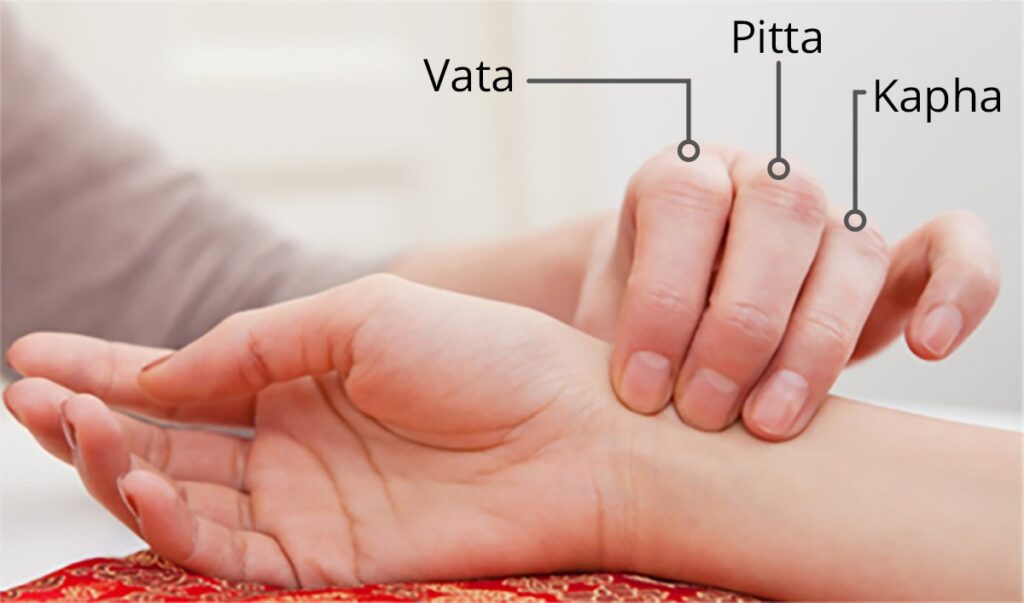
Through a combination of palpation techniques and intuitive assessment, the Ayurvedic practitioner discerns subtle variations in these pulse characteristics, which provide valuable insights into the individual’s physical and psychological state.
The Vata pulse can be determined by a thin, fast and irregular rhythm under the skin. In comparison, the Pitta pulse, which is stronger and more voluminous, and it may have either a regular or irregular rhythm. You can locate the Kapha pulse deeper down (under fatty tissue) and move slowly and regularly. The Ayurvedic practitioner can take the pulse at other parts of the body as well, thereby gaining a very complete picture of the state of health of any patient.
There are many parameters related to Nadi Pariksha which are described in Ayurveda. Gati (movement), vega (rate), tala (rhythm), bala (force), tapamana (temperature), akruti (volume and tension) and kathinya (consistency of the vessel wall) across vata, pitta and kapha doshas are very tricky to assess.
3. Nadi Gati (movement of the pulse) and their relationship with Dosha:
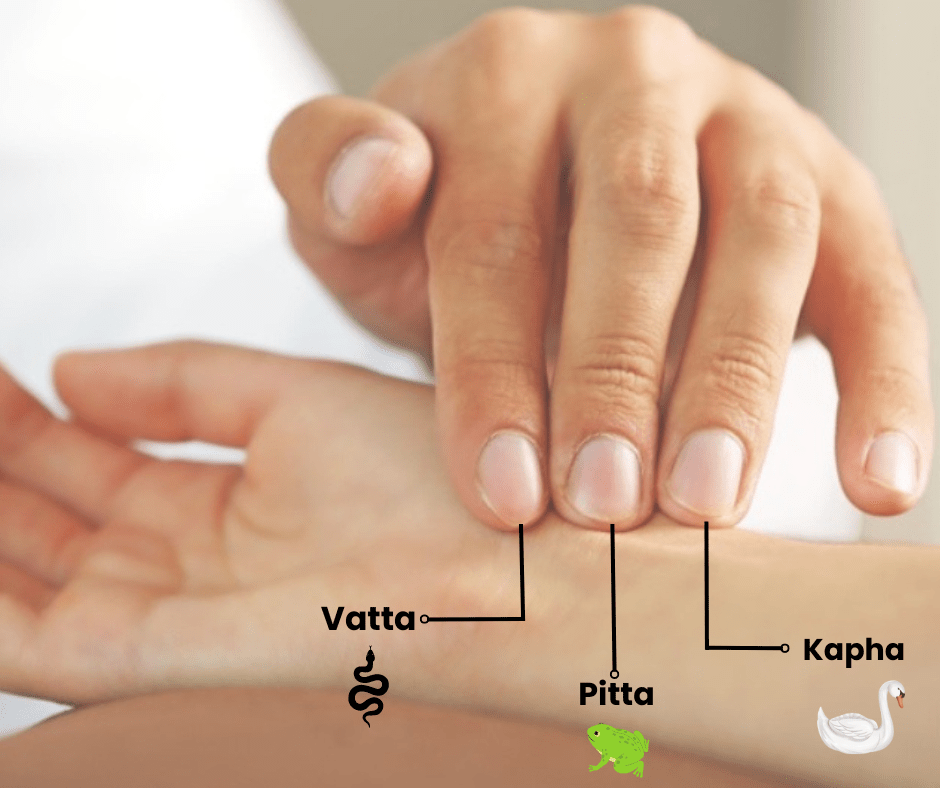
- Vata dosha: Jalauka and Sarpagati – The pulse moves like a leech or snake.
- Pitta dosha: Kulinga-kaka-Manduka gati – The movement of the pulse is like a sparrow, crow, or frog.
- Kapha dosha: Hansa and Paravata gati – The movement is like a swan or pigeon.
- Vata-Pitta dosha: Muhur sarpa gati and Muhur beka gati – The pulse sometimes moves like a snake and sometimes like a frog.
- Vata-Kapha dosha: Sarpa – hansa gati – The pulse sometimes moves like a snake and sometimes like a swan.
- Pitta-Kapha dosha: Hari-hansa gati – The pulse sometimes moves like a monkey and sometimes like a swan.
- Sannipataja or Tridoshaja: Lava-tittira-vart gamanam – The pulse movements are like a bustard quail, grey partridge, or button quail.
The dosha predominance can be well assessed with Nadi which is a very unique way of diagnosis in Ayurveda wherein the movement of the pulse has been compared with the movement of animals, birds and reptiles.
4. Key considerations while performing Nadi Pariksha:
The speed, stability etc parameters of the pulse vary with the aggravated doshas and assessing such variations with Nadi pariksha is an art and science of its own. Ayurveda has rich experience in pulse-based diagnosis but it is subjective in nature and is highly dependent on skill of the physician.
The pulse of a healthy person is steady and forceful. It beats like Hansagamana (the movements of a swan) and Gajagamini (the walking of an elephant).
5. Nadi Tarangini- New tech based face of Nadi pariksha:
In this fast-paced world where everything has to be ultra-efficient, Nadi Tarangini is an unparalleled technological advancement which can assess Nadi incorporating Ayurvedic principles.
Nadi Tarangini auscultates subtle changes in overall health parameters based on Vata, Pitta and Kapha (Tridosha) by analyzing Nadi.
As per classical texts, qualities or properties of Nadi / pulse such as pulse movement (Gati), speed of the pulse (Vega), stability of the pulse (Sthiratva), and hardness of the artery (Kathinya) play a major role in Nadi pariksha. The classical texts emphasize the significance of Gati, a unique quality of the Nadi as part of Nadi pariksha. These all parameters can be assessed by Nadi Tarangini via sensor based patented technique through digital Nadi pariksha.
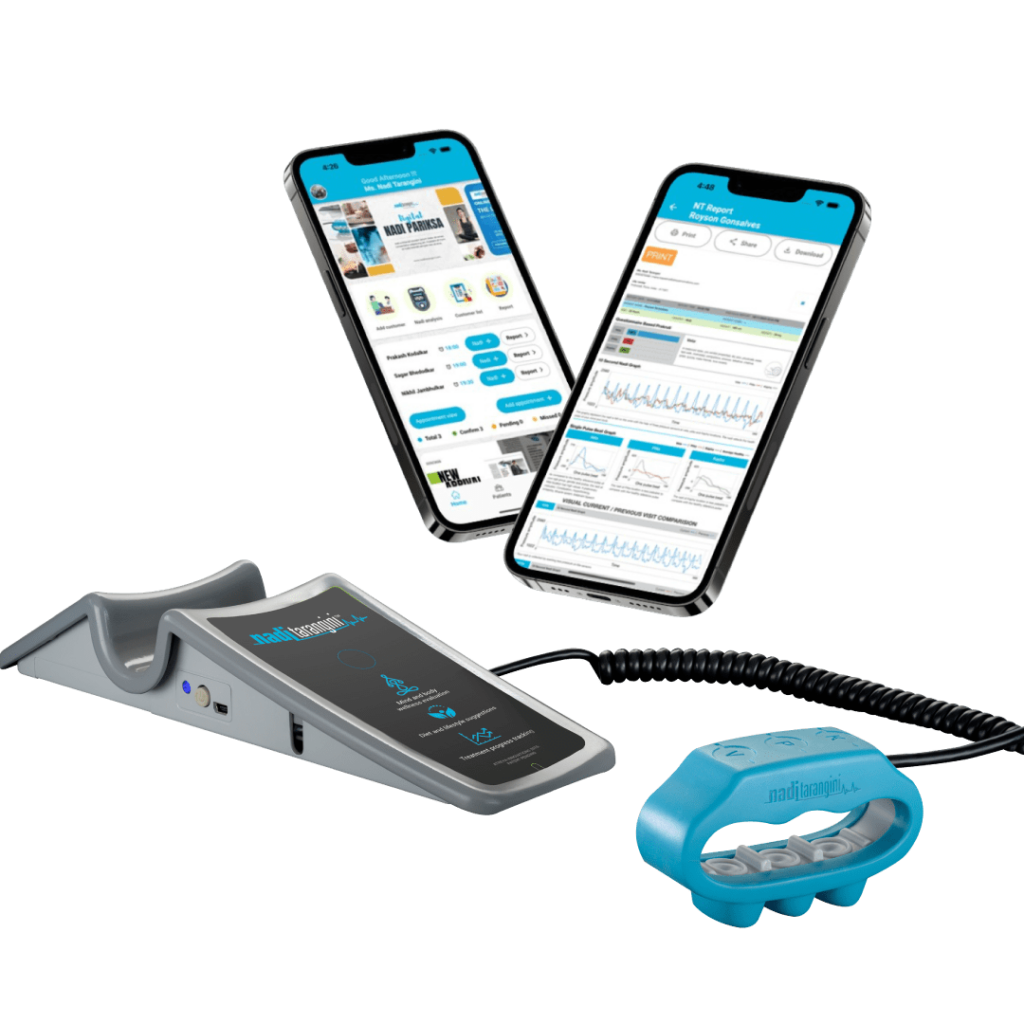
Nadi Pariksha along with metabolic health and emotional well-being can be monitored and analyzed digitally by Nadi Tarangini. A report mentioning all minute parameters is generated that is a unique Individual-specific health assessment card. The report can be assessed and co-related with associated complaints and it could be used for follow-up too.
It is a simple, non-invasive technology that enables us to reach the root cause of health issues in a personalized manner and not just address the symptoms.
This is a perfect blend of ancient Ayurveda wisdom and technology that focuses on good QoL- Quality of life for everyone’s well-being.
6. Pulse Diagnosis –A unique Non invasive diagnostic tool:
Ayurvedic pulse Diagnosis provides a gateway to empowering insights that extend far beyond the realm of physical health. It is a holistic approach that encompasses the body, mind, and spirit, recognizing the interplay of these elements in the tapestry of well-being.
- A disease manifests itself through 6 stages – accumulation, aggravation, dissemination, localization, manifestation and complication. Ayurveda always focuses on diagnosing and detecting the disease in its principal stage, which allows for prevention. Preventive value of pulse diagnosis is in eradicating minor imbalances and preventing them from turning into serious ones is very important.
- Prakruti (dosha type) and vikruti (dosha imbalance) analysis is the main associated key related to pulse diagnosis.
- Diet and lifestyle modifications can be tailored by using pulse diagnosis.
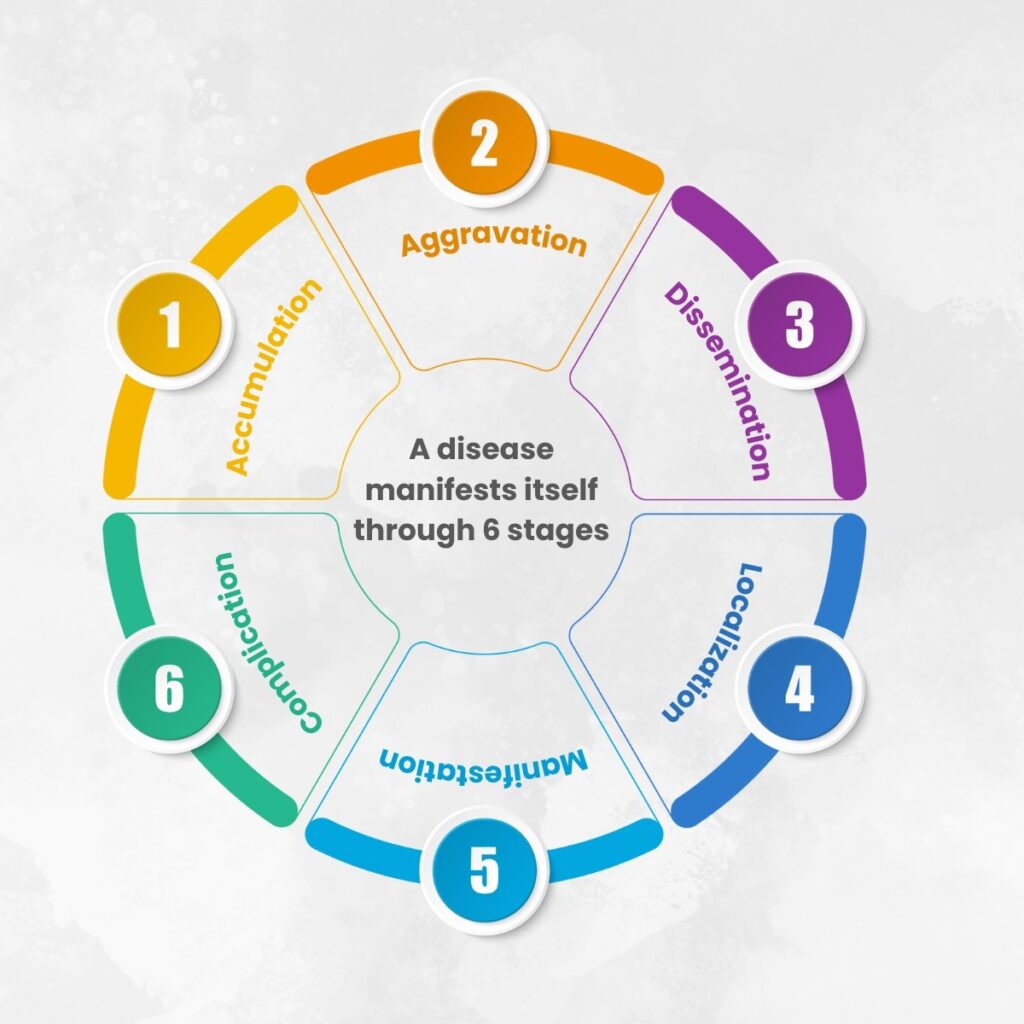
- It is useful in diagnosing imbalances within Doshas, the strength of Agni (digestive fire, metabolic activity) and abnormal mental or physical activity.
Armed with the knowledge derived from pulse diagnosis, individuals can make conscious choices in various aspects of their lives—diet, daily routines, relationships, and more. The insights gained serve as a compass.
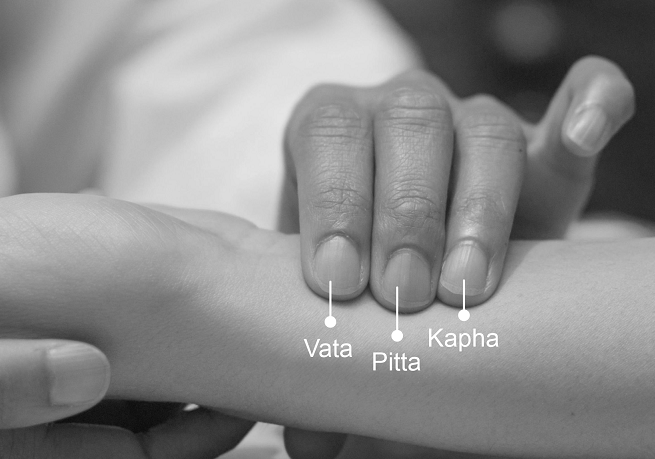
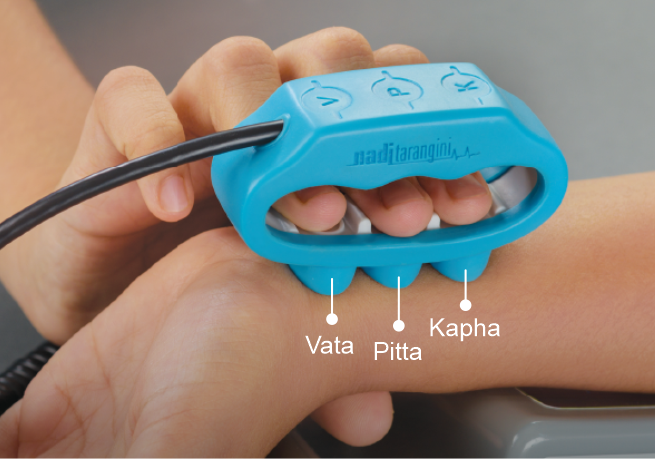
Nadi Tarangini, the sensor based pulse diagnosis device will definitely serve as a milestone and a paradigm shift for Ayurvedic practitioners. By combining the wisdom of Ayurveda with the precision of modern technology, Ayurvedic practitioners can offer their patients a more effective, data-driven, and personalized healthcare experience. This fusion of tradition and innovation not only honors the roots of Ayurveda but also prepares it for a promising future in healthcare.
Author: Dr. Gayatri Kulkarni – Mulye
MD ( Ayurved)
Special proficiency in Gynecological disorders and Infertility.
Practicing since 12 years at Orthoved hospital, Dombivli,
For regular updates, like and follow:

